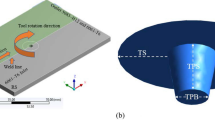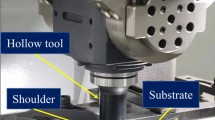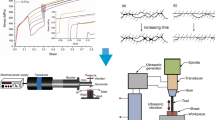Abstract
Friction stir welding (FSW) is a well-known joining process applied to materials with low weldability. The FSW process is subjected to an elevated stress state; however, there is no theoretical stresses analysis for the process. In this paper, a stress analysis for FSW process is developed using the slab method. The governing differential equations are obtained through the force equilibrium and the von Mises yield criterion and solved to determine the stress state and the maximum axial force. Several models are proposed for the normal stress components based on Coulomb and Siebel friction laws. Additionally, a division into three zones of plastic deformation is used: stick zone, drag zone, and slip zone. The effect of the temperature increase is considered and the yield stress is modeled as a function of the angular speed. Experimental axial forces are measured in order to estimate the coefficient of friction. To verify the validity of the models, a validation point and published experimental results from the literature are used. The analytical results show a good agreement with the experiments, with an average percent error of 10%. The presented models provided a useful and quick knowledge, which can be applied in the dimensioning of the FSW process.






Similar content being viewed by others
References
Thomas WM, Nicholas ED, Needham JC, Murch MG, Templesmith P, Dawes CJ (1991) G.B. Patent application no. 9125978.8; December 1991
Gite RA, Loharkar PK, Shimpi R (2019) Friction stir welding parameters and application: a review. Mater Today-Proc 19:361–365. https://doi.org/10.1016/j.matpr.2019.07.613
Mishra RS, Ma ZS (2005) Friction stir welding and processing. Mater Sci Eng R Rep 50(1–2):1–78. https://doi.org/10.1016/j.mser.2005.07.001
Senapati NP, Bhoi RK (2021) Improving the strength of friction-stir-welded joints of AA1100 alloy. J Mater Eng Perform 30:510–521. https://doi.org/10.1007/s11665-020-05331-6
Andrade DG, Leitão C, Dialami N, Chiumenti M, Rodrigues DM (2020) Modelling torque and temperature in friction stir welding of aluminium alloys. Int J Mech Sci 182:105725. https://doi.org/10.1016/j.ijmecsci.2020.105725
Zhu XK, Chao YJ (2002) Effects of temperature-dependent material properties on welding simulation. Comput Struct 80:967–976. https://doi.org/10.1016/S0045-7949(02)00040-8
Kumar K, Kalyan C, Kailas SV, Srivatsan TS (2009) An investigation of friction during friction stir welding of metallic materials. Mater Manuf Process 24:438–445. https://doi.org/10.1080/10426910802714340
Kamp N, Reynolds AP, Robson JD (2009) Modelling of 7050 aluminium alloy friction stir welding. Sci Technol Weld Joi 14:589–596. https://doi.org/10.1179/136217109X12538726589987
Terra CS, Silveira JL (2021) Models for FSW forces using a square pin profile tool. J Manuf Process 68:1395–1404. https://doi.org/10.1016/j.jmapro.2021.06.052
Quintana KJ, Silveira JL (2018) Mechanistic models for the forces in FSW of aluminum alloy 5052–H34. Int J Adv Manuf Technol 96:3993–4008. https://doi.org/10.1007/s00170-018-1859-3
Srichok T, Pitakaso R, Sethanan K, Sirirak W, Kwangmuang P (2020) Combined response surface method and modified differential evolution for parameter optimization of friction stir welding. Processes 8(9):1080. https://doi.org/10.3390/pr8091080
Zlatanovic DL, Balos S, Bergmann JP, Köhler T, Grätzel M, Sidjanin L, Goel S (2020) An experimental study on lap joining of multiple sheets of aluminium alloy (AA 5754) using friction stir spot welding. Int J Adv Manuf Technol 107:3093–3107. https://doi.org/10.1007/s00170-020-05214-z
Wang J, Liu X, Sun X (2020) Study on the relationship between asymmetrical rolling deformation zone configuration and rolling parameters. Int J Mech Sci 187:105905. https://doi.org/10.1016/j.ijmecsci.2020.105905
Farzad H, Ebrahimi R (2020) An investigation of die profile effect on die wear of plane strain extrusion using incremental slab method and finite element analysis. Int J Adv Manuf Technol 111:627–644. https://doi.org/10.1007/s00170-020-06126-8
Qi J, Liu X, Gao H, Chen J, Hu X, Yan S (2020) Experiment and analytical model based on slab method for drawing process of core filled tube. Int J Mech Sci 165:105152. https://doi.org/10.1016/j.ijmecsci.2019.105152
Wang W, Song Y, Gao D, Yoon E, Lee DJ, Lee CS, Kim HS (2013) Analysis of stress states in compression stage of high pressure torsion using slab analysis method and finite element method. Met Mater Int 19:1021–1027. https://doi.org/10.1007/s12540-013-5014-2
Hadi S, Rahimzadeh lotfabad F, Paydar MH, Ebrahimi R (2020) New mathematical stress analysis in the compressive stage of the high-pressure torsion process. Met Mater Int 27:2947–2956. https://doi.org/10.1007/s12540-020-00881-9
Tzou GY, Hsu HH, Hsiao YH (2006) Investigation of a slab method analysis and FEM simulation on rotating compression forming of ring. J Mater Process Technol 177:150–153. https://doi.org/10.1016/j.jmatprotec.2006.04.073
Chen CJ, Tzou GY, Huang MN (2006) Study on the twist compression forming of cylinder based on the upper bound and slab methods. J Mater Process Technol 174:266–271. https://doi.org/10.1016/j.jmatprotec.2005.06.091
Zhang DW, Yang H, Sun ZC (2010) Analysis of local loading forming for titanium-alloy T-shaped components using slab method. J Mater Process Technol 210:258–266. https://doi.org/10.1016/j.jmatprotec.2009.09.008
Prandtl L (1920) Über die Härte plastischer Körper. Nachrichten von der Gesellschaft der Wissenschaften zu Göttingen, Mathematisch-Physikalische Klasse, p 74–85. http://eudml.org/doc/59075
Hill R (1950) The mathematical theory of plasticity. Oxford University Press, Oxford
Tan X (2002) Comparisons of friction models in bulk metal forming. Tribol Int 35:385–393. https://doi.org/10.1016/S0301-679X(02)00020-8
Gerlich AP, Shibayanagi T (2011) Liquid film formation and cracking during friction stir welding. Sci Technol Weld Join 16(4):295–299. https://doi.org/10.1179/1362171811Y.0000000005
Tiwan, Ilman MN, Kusmono (2021) Microstructure and mechanical properties of friction stir spot welded AA5052-H112 aluminum alloy. Heliyon 7(2):e06009. Published: February 01, 2021. https://doi.org/10.1016/j.heliyon.2021.e06009
Cetkin E, Çelik YH, Kilickap E (2021) Effect of temperature, force, and vibration on fatigue strength of friction stir-welded AA7075 aluminum alloy joints. J Mater Eng Perform 30:202–211. https://doi.org/10.1007/s11665-020-05436-y
Liu FJ, Fu L, Chen HY (2018) Effect of high rotational speed on temperature distribution, microstructure evolution, and mechanical properties of friction stir welded 6061–T6 thin plate joints. Int J Adv Manuf Technol 96:1823–1833. https://doi.org/10.1007/s00170-018-1736-0
Quintana KJ, Silveira JLL (2018) Analysis for the forces in FSW for aluminum alloy considering tool geometry and process velocities. J Braz Soc Mech Sci Eng 40:229. https://doi.org/10.1007/s40430-018-1162-0
Atharifar H, Lin D, Kovacevic R (2009) Numerical and experimental investigations on the loads carried by the tool during friction stir welding. J Mater Eng Perform 18:339–350. https://doi.org/10.1007/s11665-008-9298-1
Su H, Wu CS, Pittner A, Rethmeier M (2013) Simultaneous measurement of tool torque, traverse force and axial force in friction stir welding. J Manuf Process 15:495–500. https://doi.org/10.1016/j.jmapro.2013.09.001
Trimble D, Monaghan J, O’Donnell GE (2012) Force generation during friction stir welding of AA2024-T3. CIRP Ann - Manuf Technol 61:9–12. https://doi.org/10.1016/j.cirp.2012.03.024
Nourani M, Milani AS, Yannacopoulos S (2015) On experimental optimization of friction stir welding of aluminum 6061: understanding processing-microstructure-property relations. Int J Adv Manuf Technol 79:1425–1441. https://doi.org/10.1007/s00170-015-6932-6
Funding
This study was supported by the Brazilian Federal Agency for Support and Evaluation of Graduate Education (CAPES) and the Brazilian National Council for Scientific and Technological Development (CNPq), Grant 315473/2020-7.
Author information
Authors and Affiliations
Contributions
CT: Conceptualization, methodology, software, data curation, writing-original draft, formal analysis, investigation, and project administration. JLLS: Conceptualization, methodology, investigation, resources, writing-review and editing, supervision, project administration, and funding acquisition.
Corresponding author
Ethics declarations
Ethics approval and consent to participate
Not applicable.
Consent for publication
Not applicable.
Competing interests
The authors declare no competing interests.
Additional information
Publisher's Note
Springer Nature remains neutral with regard to jurisdictional claims in published maps and institutional affiliations.
Rights and permissions
About this article
Cite this article
Terra, C., Silveira, J.L.L. Stress state analysis of friction stir welding. Int J Adv Manuf Technol 121, 1123–1134 (2022). https://doi.org/10.1007/s00170-022-09262-5
Received:
Accepted:
Published:
Issue Date:
DOI: https://doi.org/10.1007/s00170-022-09262-5




